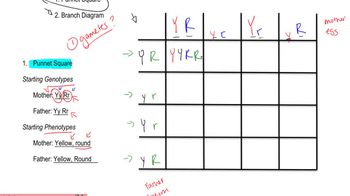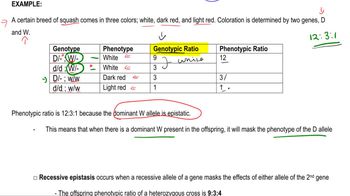Here are the essential concepts you must grasp in order to answer the question correctly.
Dihybrid Cross
A dihybrid cross involves two traits, each represented by two alleles, allowing the study of inheritance patterns for two genes simultaneously. In this case, the genes R and T are being analyzed for their interactions in producing phenotypes. The classic Mendelian ratio of 9:3:3:1 is often expected, but different interactions can lead to modified ratios, such as the 9/16 red to 7/16 white ratio mentioned.
Recommended video:
Epistasis
Epistasis occurs when the expression of one gene is affected by another gene, leading to altered phenotypic ratios. In the context of the question, the dominant alleles of genes R and T may interact in such a way that they influence pigment production differently, resulting in the observed ratios. Understanding how these genes interact is crucial for explaining the phenotypic outcomes in the F₂ progeny.
Recommended video:
Loss-of-Function Alleles
Loss-of-function alleles are mutations that result in the complete or partial inactivation of a gene, leading to a lack of functional protein. In this scenario, the recessive alleles at both loci (r and t) are null alleles, meaning they do not contribute to pigment production. This concept is essential for understanding how the presence of dominant alleles can lead to different phenotypic expressions in the progeny.
Recommended video:






